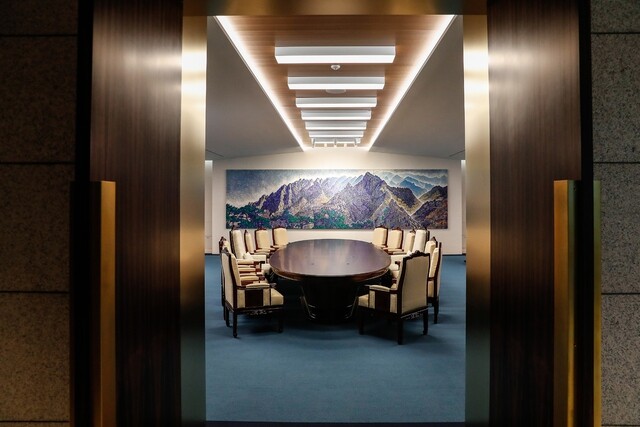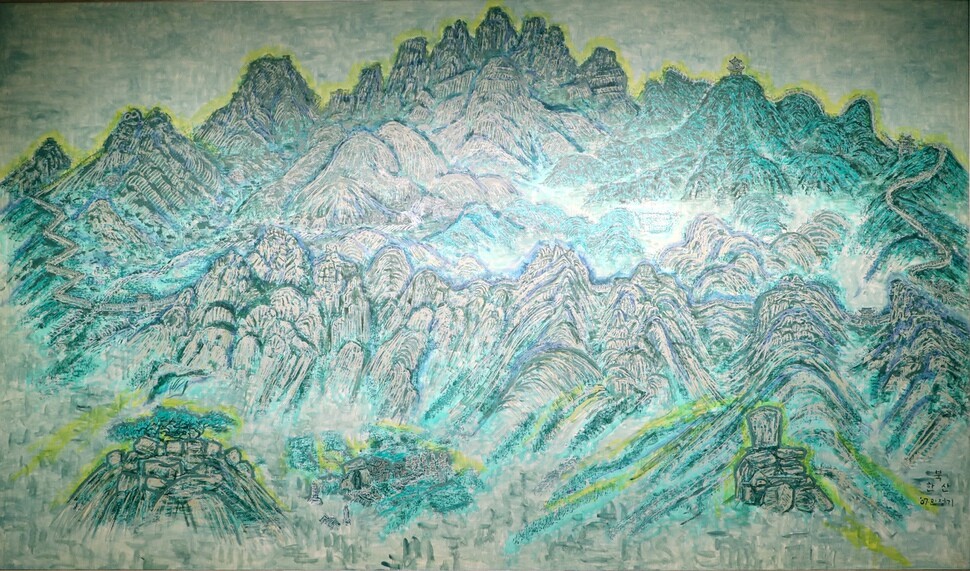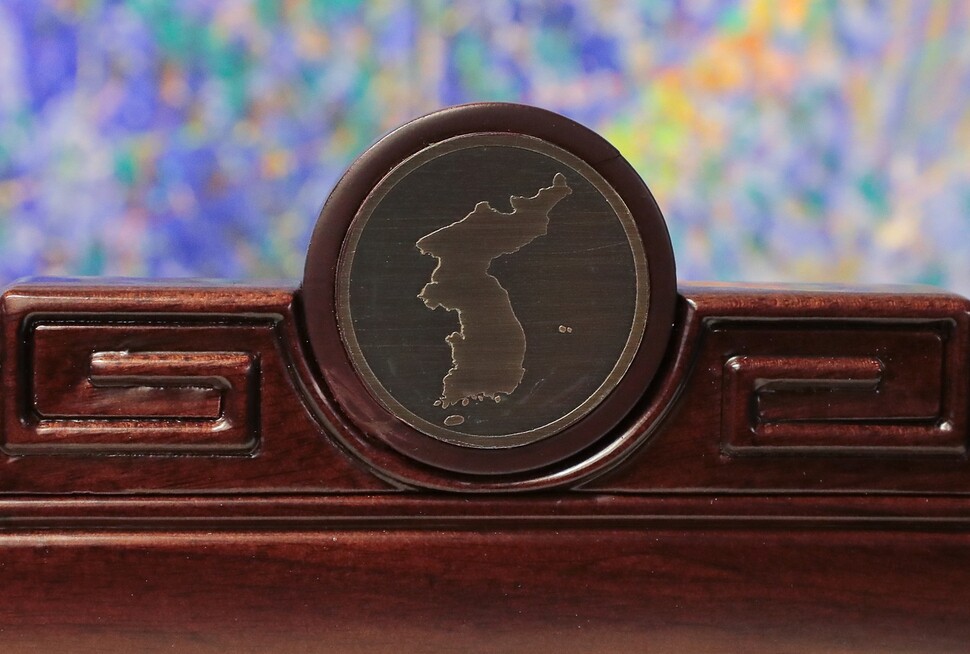hankyoreh
Links to other country sites 다른 나라 사이트 링크
Public gets advanced showing of historic inter-Korean summit site

The Korean public has gotten its first glimpse of the site of the inter-Korean summit scheduled for Apr. 27, which will turn a new page in history. On Apr. 25, the Blue House released information about the meeting room, located in the House of Peace in Panmunjeom. Instead of a square table, the room contains an oval table symbolizing harmony, and there is a painting of Mt. Kumgang on the wall. The information and explanation provided by the Blue House allows us to imagine what will happen between South Korean President Moon Jae-in and North Korean leader Kim Jong-un.
On the morning of Apr. 27, the two leaders will review the South Korean honor guard in front of the House of Peace. Just as former South Korean presidents Kim Dae-jung and Roh Moo-hyun reviewed an honor guard from the North Korean People’s Army (KPA) when they visited Pyongyang, Kim Jong-un will review an honor guard picked from the three armed forces (the ROK Army, Navy and Air Force) when he visits the southern side of Panmunjeom, South Korea’s Ministry of Defense announced on Apr. 25. Because of the limited space at Panmunjeom, the honor guard review will be held on a reduced scale.
After this, Moon and Kim will walk side by side to the House of Peace, passing through the entrance together. This is a departure from previous inter-Korean talks held here, during which the South and North Korean delegations used separate entrances, the South Koreans on the left and the North Koreans on the right.
After entering the first floor lobby, the two leaders will sign the visitors’ log. The table used for the signing is modeled on a Haeju soban, a small folding table. After signing the log, the two leaders will pass into the parlor on the same floor. The parlor is decorated in a neat white: its walls are lined with hanji, a traditional Korean paper, and the chairs are draped in ramie fiber.

According to the Blue House, the understated aesthetic of the “people clad in white” (as Koreans were once known) is used to suggest a host warmly welcoming a guest into his home. At various locations in this room are white moon jars filled with flowers: peony, regarded as the king of flowers; the purple blossoms of the redbud, which symbolize friendship; the daisy, which is an emblem of peace; the lily of the valley, which is said to convey happiness and joy; wildflowers that grow in the DMZ (demilitarized zone); and the yellow rape flower from Jeju Island. “Under the theme of welcome and consideration, the first floor conveys a message of welcome and joy about the invitation of the guest,” the Blue House said.

Meeting room interior modeled after a hanok
After some light conversation, the two leaders will move to the meeting room for the summit, which is on the second floor. The inside of the room evokes a hanok, or traditional Korean house. The room was renovated between Apr. 6 and 20 to evoke the mood of a traditional wooden porch. Traditional windows have been added to the walls on both sides to add to the homey atmosphere. These windows were built in the traditional method, using grooves, without any nails or glue. “This communicates our hope that the strong relationship of trust between South and North Korea will last as long as these traditional windows,” the Blue House said.
The color of the meeting room is blue, and there is a blue carpet on the floor. On the wall is a large painting of Mt. Kumgang, measuring 681cm wide and 181cm high. Until renovations were done on the interior of the House of Peace, a painting of Mt. Halla on Jeju Island had been hanging here. The painting, which is called “Mt. Kumgang Seen from Sangpal Pool,” is by Shin Jang-sik, who is known as the “artist of Mt. Kumgang.”

The table at which the two leaders will sit to discuss peace and the denuclearization of the Korean Peninsula is oval in shape. This brings the two leaders closer together than the square table where leaders from the two sides sat during the two previous summits. The table, which was made expressly for this meeting, is 5,400mm long and 2,018mm wide, the width symbolizing the year of the summit. Placed in the middle of the table are the leaders’ chairs, the backs of which are two spans higher than the other chairs. An emblem of the map of the Korean Peninsula is engraved on the upper part of the chair backs.
“This was designed to reduce the psychological distance of 70 years of division and the physical boundary of the armistice line so that [the two sides] could sit down and engage in candid conversation. The overall shape of the table was designed so that the two legs would join into one, which was modeled after the railing on bridges at the old palaces,” said Koh Min-jeong, deputy spokesperson for the Blue House.


Aside from Moon and Kim, the question of who will be sitting around this table remains undecided. Moon will be officially accompanied by six people: Summit Preparatory Committee Chairman Im Jong-seok, Blue House National Security Office Director Chung Eui-yong, National Intelligence Service Director Suh Hoon, Unification Minister Cho Myoung-gyon, Foreign Minister Kang Kyung-wha and Defense Minister Song Young-moo.
During the summits in 2000 and 2007, the North Korean leader was only accompanied by one person: first Kim Yong-sun and then Kim Yang-gon, both directors of the North Korean Workers’ Party’s United Front Department. At this summit, it seems clear that Kim Jong-un will be accompanied by United Front Department Director Kim Yong-chol. The two leaders will take hold of the microphones in front of them, and the meeting will begin.
In the evening, after the summit is complete, the two leaders will retire to an official dinner room on the third floor of the building. The color of this room is a refreshing green, and the carpet and curtains are the same color. “This signifies how South and North Korea are peacefully becoming one, as if they were holding hands as they walk through the vivid green of a barley field at the height of spring in April,” the Blue House said.
The two leaders will dine on fresh naengmyeon (cold noodles) prepared at Panmungak Hall, on the North Korean side of Panmunjeom, by senior chefs from the Pyongyang Okryu-gwan restaurant; grilled John Dory fish, a local delicacy from Moon’s hometown; and rösti, or Swiss potato pancakes, a favorite of Kim’s during his years spent studying in Switzerland. There will also be the occasional clinking of glasses filled with dugyeonju, a liquor brewed with azalea flowers, and munbaeju, a prized traditional spirit. The hour will grow late as the two leaders spend a peaceful and atmospheric spring evening together.
By Park Byong-su, senior staff writer and Seong Yeon-cheol, staff reporter
Please direct questions or comments to [english@hani.co.kr]

Editorial・opinion
![[Guest essay] The real reason Korea’s new right wants to dub Rhee a founding father [Guest essay] The real reason Korea’s new right wants to dub Rhee a founding father](https://flexible.img.hani.co.kr/flexible/normal/500/300/imgdb/original/2024/0423/8317138574257878.jpg) [Guest essay] The real reason Korea’s new right wants to dub Rhee a founding father
[Guest essay] The real reason Korea’s new right wants to dub Rhee a founding father![[Column] ‘Choson’: Is it time we start referring to N. Korea in its own terms? [Column] ‘Choson’: Is it time we start referring to N. Korea in its own terms?](https://flexible.img.hani.co.kr/flexible/normal/500/300/imgdb/original/2024/0423/3617138579390322.jpg) [Column] ‘Choson’: Is it time we start referring to N. Korea in its own terms?
[Column] ‘Choson’: Is it time we start referring to N. Korea in its own terms?- [Editorial] Japan’s rewriting of history with Korea has gone too far
- [Column] The president’s questionable capacity for dialogue
- [Column] Are chaebol firms just pizza pies for families to divvy up as they please?
- [Column] Has Korea, too, crossed the Rubicon on China?
- [Correspondent’s column] In Japan’s alliance with US, echoes of its past alliances with UK
- [Editorial] Does Yoon think the Korean public is wrong?
- [Editorial] As it bolsters its alliance with US, Japan must be accountable for past
- [Guest essay] Amending the Constitution is Yoon’s key to leaving office in public’s good graces
Most viewed articles
- 1[Column] ‘Choson’: Is it time we start referring to N. Korea in its own terms?
- 2Senior doctors cut hours, prepare to resign as government refuses to scrap medical reform plan
- 3Why Korea shouldn’t welcome Japan’s newly beefed up defense cooperation with US
- 4Opposition calls Yoon’s chief of staff appointment a ‘slap in the face’
- 5[Guest essay] The real reason Korea’s new right wants to dub Rhee a founding father
- 6Terry Anderson, AP reporter who informed world of massacre in Gwangju, dies at 76
- 7[Column] The clock is ticking for Korea’s first lady
- 8[Editorial] Japan’s rewriting of history with Korea has gone too far
- 9New AI-based translation tools make their way into everyday life in Korea
- 10Survey: S. Koreans spend more time using smartphones than eating